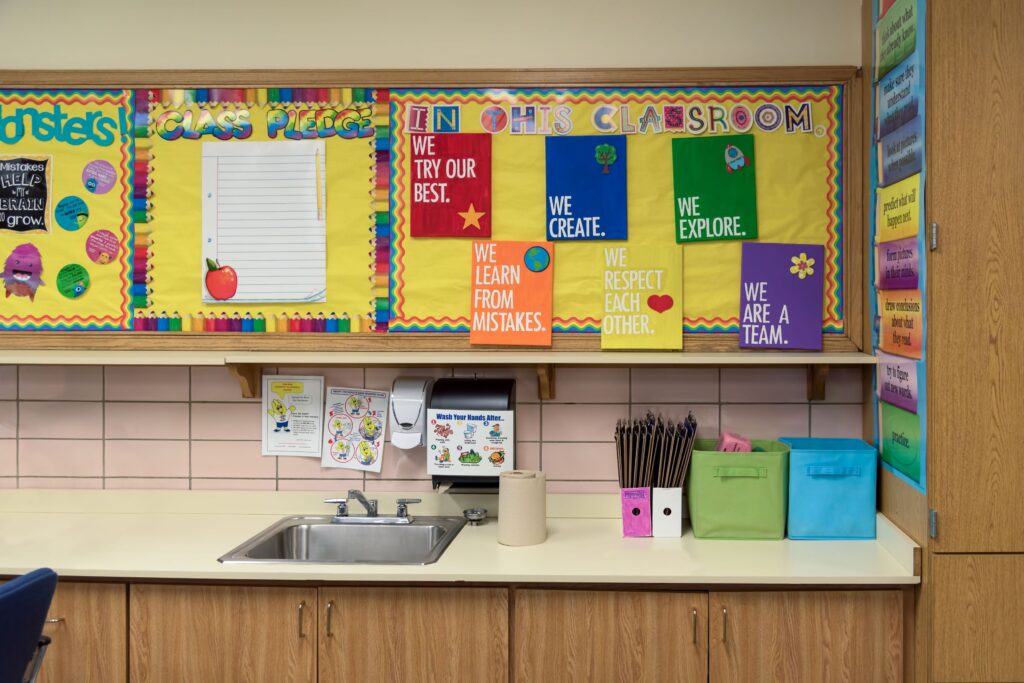For years, bulletin boards have been the silent, often underutilized, canvases of our classrooms – primarily serving as decorative backdrops for student work or seasonal themes. These vibrant displays can be more than just pretty pictures, transforming into dynamic, interactive learning hubs that actively engage students and reinforce educational concepts.
As educators, we are constantly seeking innovative ways to deepen student understanding and create a truly immersive learning environment. The good news? One of our most readily available and cost-effective tools is right there on our classroom walls.
Let’s explore how to transcend traditional bulletin board design, turning them into powerful pedagogical instruments that weave learning seamlessly into the fabric of your classroom.
The Untapped Potential of Your Classroom Walls
Think back to your own teaching journey. Perhaps you recall a moment when a student, captivated by a visual aid you created, suddenly grasped a complex concept. Or maybe you’ve seen the spark of curiosity ignite in a child’s eyes as they interact with a hands-on display. These moments underscore the immense power of visual and interactive learning.
While the market offers a plethora of pre-made bulletin board sets designed for specific themes or holidays (and indeed, many of them are visually appealing!), relying solely on these can inadvertently limit the educational impact of your classroom displays.
Our goal isn’t to dismiss the value of aesthetics, but rather to elevate the purpose of our bulletin board decorations beyond mere decoration. We’re moving past just decorative bulletin boards to truly integrated learning tools.
From Static Displays to Dynamic Learning Hubs: A Pedagogical Shift
The key to transforming bulletin boards lies in a fundamental shift in design philosophy. Instead of seeing them as finished products, consider them as evolving ecosystems of knowledge. Here’s how to integrate learning deeply into your bulletin board decorations:
Curate for Curriculum, Not Just Cuteness
Before you even think about colors or borders, ask yourself: What specific learning objectives can this bulletin board support?
- Align with Learning Standards: Directly tie your bulletin board content to your grade-level curriculum standards. If you’re teaching fractions, design a board that visually explains equivalent fractions, rather than just displaying student work on the topic.
- Concept Reinforcement: Use bulletin boards to reinforce key concepts being taught in class. This could be a visual glossary of vocabulary words, a timeline of historical events, or a step-by-step guide to solving a math problem.
- Pre-teach and Review: Introduce new concepts with a “preview” board or create a “review” board as a quick reference for students before an assessment.
Embrace Interactivity: Hands-On Learning on the Wall
This is where your bulletin boards truly come alive. Static displays, no matter how informative, are less engaging than those that invite participation. Consider these ideas to decorate bulletin boards for schools with an interactive twist:
- Lift-the-Flap Activities: Create flaps that reveal answers, definitions, or additional information. For example, a science board on the water cycle could have flaps that describe each stage.
- Matching Games: Attach Velcro dots or magnets to cards for students to match words to definitions, pictures to concepts, or equations to solutions.
- Pockets and Envelopes: Store task cards, challenge questions, or small manipulatives for students to use. A reading comprehension board could have envelopes containing questions about a featured book.
- Write-On/Wipe-Off Surfaces: Laminate sections of your board or use dry-erase pockets to allow students to write answers, solve problems, or contribute ideas directly on the display.
- QR Code Integration: Embed QR codes that link to educational videos, interactive websites, online quizzes, or audio explanations. This can extend the learning beyond the physical space of the board.
Foster Student Ownership: Their Learning, Their Display
When students are involved in the creation of bulletin boards, their engagement and understanding skyrocket.
- Student-Generated Content: Instead of just displaying finished projects, guide students in creating elements for the bulletin board. This could be their own explanations, drawings, or research findings related to a topic.
- Collaborative Design: Allow students to work in groups to design sections of a larger bulletin board, fostering teamwork and shared responsibility.
- “What Do You Know?” Boards: Start a unit with a blank or partially complete board and have students contribute their prior knowledge or questions as the unit progresses.
- Showcasing the Learning Process: Go beyond simply displaying the “right” answer. Show student thinking, drafts, and revisions to highlight the learning journey.
Design for Accessibility and Visibility
Even the most brilliant learning board won’t be effective if it’s not accessible or easy to understand.
- Clear and Concise Language: Use age-appropriate vocabulary and avoid jargon.
- Legible Fonts and Sizing: Ensure all text is large enough and easy to read from a distance.
- Strategic Placement: Position boards at eye level for students. Consider traffic flow in the classroom and ensure they are in areas where students can easily interact with them.
- Visual Organization: Use headings, subheadings, bullet points, and visual cues (arrows, shapes) to break up information and guide the eye.
- Maintain and Refresh: Bulletin boards should be dynamic. Update content regularly to keep it fresh and relevant to ongoing lessons. Rotate student work to give everyone a chance to be featured.
Leverage Technology Wisely (But Don’t Over-Rely)
While technology can enhance bulletin boards, remember that the core value lies in the interaction and educational content.
- Digital Displays: Consider using a projector or interactive whiteboard to create “digital bulletin boards” that can incorporate videos, animations, and real-time updates.
- Online Resources: As mentioned with QR codes, link to reputable online resources that extend the learning.
- Avoid Overwhelm: Don’t let technology overshadow the simplicity and directness of a well-designed physical board. Balance is key.
Weaving the Fabric of Learning: Practical Examples
Let’s consider how these principles can be applied in different subject areas. Thinking about decor for bulletin boards with these examples can spark even more ideas:
- Elementary Literacy: A “Word Family Forest” bulletin board where students can add leaves with different word families (e.g., -at, -en) or “Story Elements S’mores” where each s’more component represents a story element (character, setting, plot). These interactive bulletin board decorations make learning fun and tangible.
- Middle School Science: A “Phases of the Moon” board with movable moon cutouts and interactive questions, or a “Human Body Systems” board with lift-the-flap descriptions of each organ.
- High School History: A “Timeline of Revolutions” with student-researched events and QR codes linking to primary source documents, or a “Debate Corner” where students can post arguments for historical events.
- Mathematics: A “Problem-Solving Pathway” board that visually breaks down multi-step problems, or a “Geometry Grab Bag” with different shape manipulatives and challenge cards. Effective bulletin board decoration for classroom use can simplify complex concepts.
The Benefits Beyond the Board
Investing time and creativity into educational bulletin boards offers a wealth of benefits:
- Increased Student Engagement: Interactive and relevant displays naturally draw students in.
- Enhanced Retention: Visual and hands-on learning improves memory and recall.
- Differentiated Instruction: Bulletin boards can cater to various learning styles (visual, kinesthetic, auditory via QR codes).
- Promotes Independence: Students can use boards as self-directed learning tools or reference points.
- Creates a Rich Learning Environment: Transforms the classroom into a vibrant space that constantly reinforces learning.
- Boosts Classroom Culture: Student-created elements foster a sense of pride and community.
Conclusion: Your Walls, Your Classroom’s Story
The classroom bulletin board is more than just a decorative space; it’s an integral part of your teaching toolkit, a silent partner in the journey of learning.
By intentionally weaving learning into every border, every cutout, and every interactive element, we can transform these bulletin board decorations into dynamic learning hubs that inspire curiosity, deepen understanding, and truly reflect the vibrant educational experiences happening within our classrooms.
So, the next time you approach your bulletin board, see it not as a blank canvas waiting for pretty pictures, but as an exciting opportunity to tell your classroom’s unique learning story. What educational concept will your next bulletin board help illuminate?
Educators never stop learning; check out our available graduate degree programs to hone your skills and promote lifelong learning and academic excellence.




